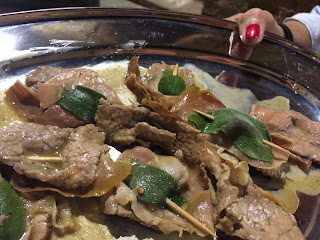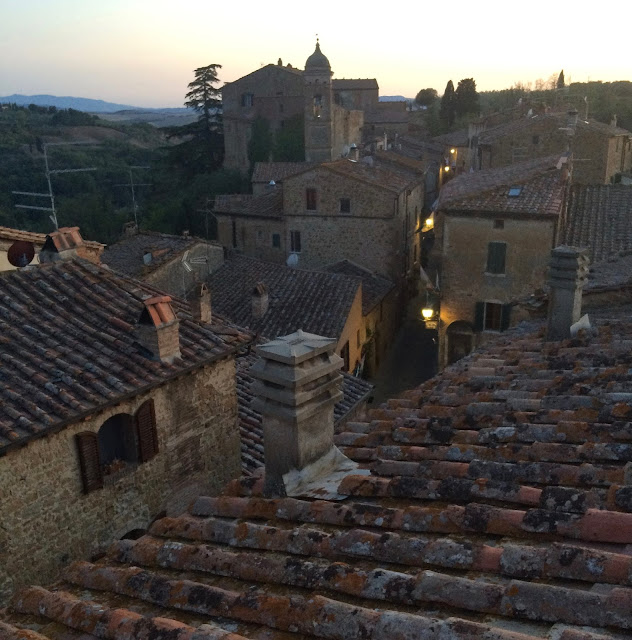One of the aspects of traveling that we most cherish are the opportunities to glean at least a glimpse local life from an emic or insider perspective. We were fortunate to be provided that opportunity on this trip when we were invited to a contrada dinner (cena) in Montisi.
The hosting contrada, Castello, is one of four contrade in Montisi, a hilltop hamlet of fewer than 400 residents. The translations "neighborhoods" or "disticts" don't adequately reflect the concept as each contrada is responsible for its partizanos (residents), assuming responsibility for each other in every regard.
In medieval times, the contrade were organized by trades. For example, all the fornos (bakeries) were in one neighborhood, the blacksmith shops in another and the tailors in yet another. Each was expected to raise funds and an army to protect the larger commune. This is no longer the case, although contrade are still identified by neighborhood. Much like one's alma mater, each contrada has its colors, logo, motto (if not fight song), and there is much pride involved!
Impressions from the Castillo Contrada Cena - Saturday, 26 August 2017
After meandering down the cobbled streets of Montisi, we arrived at 8PM to find tables set up down the center of the narrow stone roadway in the heart of the Castello Contrada.
Yellow and white table clothes accented with bright blue water bottles (naturale e frizante) adorned each table, representing the three colors of the Castillo Contrada.

Electric lights illuminated stone walls that were constructed in the 12th century to reflect torchlight.
At least eighty people (as wel as a passel of well mannered dogs) mingled, drinking white wine from plastic cups. Mellifluous rhythms of the Italian language harmonized with varieties of English (US, UK, Australian, and Italian-English). The resulting linguistic symphony was underscored by the bass beat of music projected from strategically placed speakers, punctuated by much laughter and broad gestures.
Every member of the Castello Contrada somehow contributed to this event.
Most notable was the Squadra di Cucina (kitchen team).
 We began with perfectly prepared tempura vegetables: broccoli, artichoke hearts and zucchini that were skewered and served in paper cones. They were truly delectable, and we were tempted to ask for seconds; however, we had been forewarned that there was molto food yet to come.
We began with perfectly prepared tempura vegetables: broccoli, artichoke hearts and zucchini that were skewered and served in paper cones. They were truly delectable, and we were tempted to ask for seconds; however, we had been forewarned that there was molto food yet to come.
Two different pasta dishes followed, with plenty of time in between for conversation. At this point, glass pitchers of vino da tavola rosso (red table wine) were brought out.
The pasta dishes were followed by the purpose of the cena, which was to recognize and appreciate the participants in this year's jousting competition (see previous post - Montisi).
 Next came the Oxtail Stew... served with potatoes and Roman style bread which uses salt.
Next came the Oxtail Stew... served with potatoes and Roman style bread which uses salt.Note: Tuscan bread is rather bland, as salt is not used. The explanations vary as to why this is the case. The most popular explanation is that salt was very expensive, especially as it was taxed. Nonetheless, this bread was divine!
Not done yet! Four courses yet to go...
...starting with a lovely saltimbocca and sage, held together with stuzzicadenti - toothpicks (my favorite word in Italian!)
Then came the amazing mushrooms...
After all was cleared away, fresh cut peaches were served in little cups with stuzzicadenti (I just had to use that word again!), and we thought we were done. However, we were premature in that assumption..
The grand finale consisted of warm chocolate filled sugar sprinkled donuts that were the quintessential definition of decadently delicious!
 |
| Marco - Captain of the Castello Contrada |

Needless to say, we left with full bellies, and also with full hearts! This is the soul of Tuscany, especially this very special place called Montisi.
Ann Lippincott
Santa Barbara, California










































































